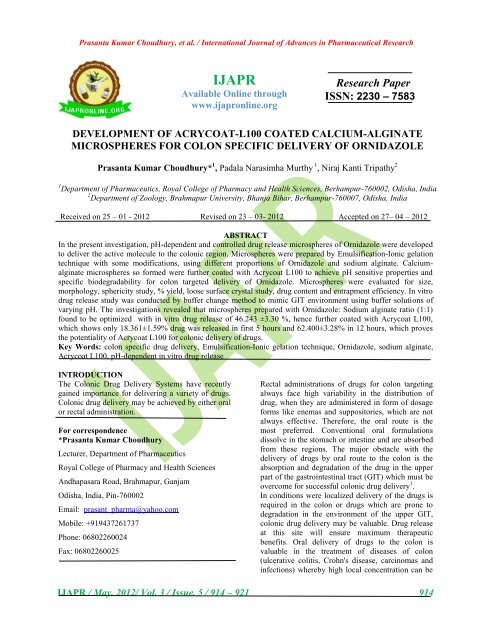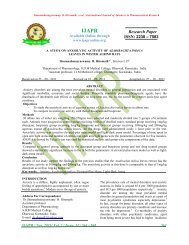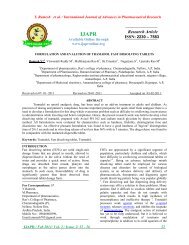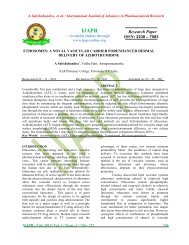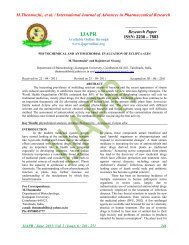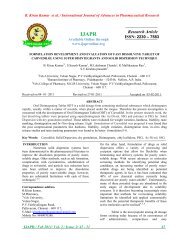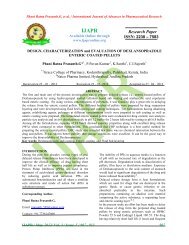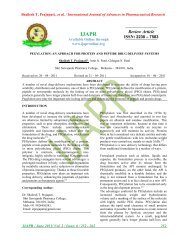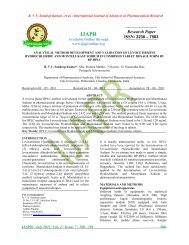formulation and characterizatin of transdermal patches by using ...
formulation and characterizatin of transdermal patches by using ...
formulation and characterizatin of transdermal patches by using ...
You also want an ePaper? Increase the reach of your titles
YUMPU automatically turns print PDFs into web optimized ePapers that Google loves.
Prasanta Kumar Choudhury, et al. / International Journal <strong>of</strong> Advances in Pharmaceutical Research<br />
IJAPR<br />
Available Online through<br />
www.ijapronline.org<br />
Research Paper<br />
ISSN: 2230 – 7583<br />
DEVELOPMENT OF ACRYCOAT-L100 COATED CALCIUM-ALGINATE<br />
MICROSPHERES FOR COLON SPECIFIC DELIVERY OF ORNIDAZOLE<br />
Prasanta Kumar Choudhury* 1 , Padala Narasimha Murthy 1 , Niraj Kanti Tripathy 2<br />
1 Department <strong>of</strong> Pharmaceutics, Royal College <strong>of</strong> Pharmacy <strong>and</strong> Health Sciences, Berhampur-760002, Odisha, India<br />
2 Department <strong>of</strong> Zoology, Brahmapur University, Bhanja Bihar, Berhampur-760007, Odisha, India<br />
Received on 25 – 01 - 2012 Revised on 23 – 03- 2012 Accepted on 27– 04 – 2012<br />
ABSTRACT<br />
In the present investigation, pH-dependent <strong>and</strong> controlled drug release microspheres <strong>of</strong> Ornidazole were developed<br />
to deliver the active molecule to the colonic region. Microspheres were prepared <strong>by</strong> Emulsification-Ionic gelation<br />
technique with some modifications, <strong>using</strong> different proportions <strong>of</strong> Ornidazole <strong>and</strong> sodium alginate. Calciumalginate<br />
microspheres so formed were further coated with Acrycoat L100 to achieve pH sensitive properties <strong>and</strong><br />
specific biodegradability for colon targeted delivery <strong>of</strong> Ornidazole. Microspheres were evaluated for size,<br />
morphology, sphericity study, % yield, loose surface crystal study, drug content <strong>and</strong> entrapment efficiency. In vitro<br />
drug release study was conducted <strong>by</strong> buffer change method to mimic GIT environment <strong>using</strong> buffer solutions <strong>of</strong><br />
varying pH. The investigations revealed that microspheres prepared with Ornidazole: Sodium alginate ratio (1:1)<br />
found to be optimized with in vitro drug release <strong>of</strong> 46.243 ±3.30 %, hence further coated with Acrycoat L100,<br />
which shows only 18.361±1.59% drug was released in first 5 hours <strong>and</strong> 62.400±3.28% in 12 hours, which proves<br />
the potentiality <strong>of</strong> Acrycoat L100 for colonic delivery <strong>of</strong> drugs.<br />
Key Words: colon specific drug delivery, Emulsification-Ionic gelation technique, Ornidazole, sodium alginate,<br />
Acrycoat L100, pH-dependent in vitro drug release<br />
INTRODUCTION<br />
The Colonic Drug Delivery Systems have recently<br />
gained importance for delivering a variety <strong>of</strong> drugs.<br />
Colonic drug delivery may be achieved <strong>by</strong> either oral<br />
or rectal administration.<br />
For correspondence<br />
*Prasanta Kumar Choudhury<br />
Lecturer, Department <strong>of</strong> Pharmaceutics<br />
Royal College <strong>of</strong> Pharmacy <strong>and</strong> Health Sciences<br />
Andhapasara Road, Brahmapur, Ganjam<br />
Odisha, India, Pin-760002<br />
Email: prasant_pharma@yahoo.com<br />
Mobile: +919437261737<br />
Phone: 06802260024<br />
Fax: 06802260025<br />
Rectal administrations <strong>of</strong> drugs for colon targeting<br />
always face high variability in the distribution <strong>of</strong><br />
drug, when they are administered in form <strong>of</strong> dosage<br />
forms like enemas <strong>and</strong> suppositories, which are not<br />
always effective. Therefore, the oral route is the<br />
most preferred. Conventional oral <strong>formulation</strong>s<br />
dissolve in the stomach or intestine <strong>and</strong> are absorbed<br />
from these regions. The major obstacle with the<br />
delivery <strong>of</strong> drugs <strong>by</strong> oral route to the colon is the<br />
absorption <strong>and</strong> degradation <strong>of</strong> the drug in the upper<br />
part <strong>of</strong> the gastrointestinal tract (GIT) which must be<br />
overcome for successful colonic drug delivery 1 .<br />
In conditions were localized delivery <strong>of</strong> the drugs is<br />
required in the colon or drugs which are prone to<br />
degradation in the environment <strong>of</strong> the upper GIT,<br />
colonic drug delivery may be valuable. Drug release<br />
at this site will ensure maximum therapeutic<br />
benefits. Oral delivery <strong>of</strong> drugs to the colon is<br />
valuable in the treatment <strong>of</strong> diseases <strong>of</strong> colon<br />
(ulcerative colitis, Crohn's disease, carcinomas <strong>and</strong><br />
infections) where<strong>by</strong> high local concentration can be<br />
IJAPR / May. 2012/ Vol. 3 / Issue. 5 / 914 – 921 914
Prasanta Kumar Choudhury, et al. / International Journal <strong>of</strong> Advances in Pharmaceutical Research<br />
achieved while minimizing side effects that occur<br />
because <strong>of</strong> release <strong>of</strong> drugs in the upper GIT or help<br />
to avoid unnecessary systemic absorption <strong>of</strong> the<br />
drug. Ulcerative colitis is the inflammatory disease<br />
<strong>of</strong> the colonic mucosa which is usually treated with<br />
salicylates or glucocorticoids. However, during the<br />
periods <strong>of</strong> remission, Ornidazole is the drug <strong>of</strong><br />
choice. In this case it is desirable to localize the<br />
release <strong>of</strong> Ornidazole to the afflicted site in the<br />
colon. Thus, Ornidazole was used as a model drug in<br />
the present study 2 .<br />
Ornidazole, a 5-nitroimidazole derivative<br />
with anti-protozoal <strong>and</strong> anti bacterial properties<br />
against anaerobic bacteria was selected as a drug <strong>of</strong><br />
choice to develop enteric coated microsphere<br />
<strong>formulation</strong> to minimize the influence <strong>of</strong> the stomach<br />
emptying time on drug release <strong>and</strong> to guarantee that<br />
the microspheres could enter the small intestine<br />
intact for treatment <strong>of</strong> some colonic diseases like<br />
ulcerative colitis, irritable bowel syndrome 2 .<br />
MATERIALS AND METHODS<br />
Materials<br />
Ornidazole was obtained as a gift sample from Micro<br />
Lab. Limited, Chennai, India, Sodium Alginate <strong>and</strong><br />
light liquid paraffin procured from Loba Chemie<br />
Ltd, Mumbai, India. Acrycoat- L100 procured from<br />
Corel Pharma-Chem, Gujarat, India. Span 80 was<br />
procured from s.d. fine-chem Ltd., Mumbai, India.<br />
All other solvents <strong>and</strong> reagents were <strong>of</strong> analytical<br />
grade. All the other chemicals <strong>and</strong> solvents used<br />
were <strong>of</strong> laboratory reagent grade.<br />
EXPERIMENTAL METHOD<br />
Characterization <strong>of</strong> drug <strong>and</strong> analytical studies<br />
The drug was characterized for Physical appearance,<br />
Solubility, UV spectral analysis, IR Spectral<br />
analysis.<br />
Drug Polymer Interaction Study <strong>by</strong> FTIR<br />
Analysis 3<br />
To eliminate the possibility <strong>of</strong> polymer interfering<br />
with the analysis <strong>of</strong> drug, Infra-red spectrum was<br />
taken <strong>by</strong> <strong>using</strong> the Shimadzu, FTIR model no.<br />
affinity-1 <strong>by</strong> scanning the sample in potassium<br />
bromide (KBr) discs. Before taking the spectrum <strong>of</strong><br />
the sample, a blank spectrum <strong>of</strong> air background was<br />
taken. The sample <strong>of</strong> pure drug, pure polymer <strong>and</strong><br />
the <strong>formulation</strong>s/physical mixtures containing both<br />
the drug <strong>and</strong> polymer were scanned.<br />
Preparation <strong>of</strong> Sodium- alginate microspheres 4<br />
The sodium alginate microspheres were prepared <strong>by</strong><br />
Emulsification-Ionic gelation method. The Sodium<br />
alginate dissolved in distilled water to form a<br />
homogenous polymer aqueous solution. Then<br />
Ornidazole was added to the aqueous solution<br />
containing Sodium alginate with thorough stirring to<br />
form a smooth viscous dispersion. The resulting<br />
dispersion was then added in a thin stream to liquid<br />
paraffin (light) containing span 80 (1 % w/v) in a<br />
beaker while stirring at 1000 rpm <strong>by</strong> <strong>using</strong> a<br />
mechanical stirrer. The stirring was continued for 5<br />
minutes to emulsify the added dispersion as fine<br />
droplets. Calcium chloride (10% w/v) solution was<br />
then added slowly while stirring for ionic gelation<br />
(or curing) reaction. Stirring was continued for 15<br />
minutes to complete the curing reaction <strong>and</strong> to<br />
produce spherical microspheres. The mixture was<br />
then centrifuged <strong>and</strong> the product thus separated was<br />
washed repeatedly with water <strong>and</strong> dried at 60°c for 6<br />
hours. By <strong>using</strong> this method, microspheres <strong>of</strong><br />
different drug: polymer ratio (2:1, 1:1, 1:2), were<br />
prepared. The microspheres prepared were coded as<br />
SAM. The composition <strong>of</strong> different <strong>formulation</strong>s is<br />
mentioned in Table 1.<br />
Coating <strong>of</strong> Sodium-alginate microspheres 5 :<br />
Coating <strong>of</strong> sodium alginate microspheres containing<br />
ornidazole was performed <strong>using</strong> emulsion solvent<br />
evaporation technique. Sodium alginate<br />
microspheres were suspended in 15 ml <strong>of</strong> an organic<br />
solvent (1:1, acetone: methanol) in which Acrycoat<br />
L-100 was previously dissolved to give 1:5 core/coat<br />
ratio. This organic phase was emulsified into 100ml<br />
<strong>of</strong> liquid paraffin containing span 80 (1% w/v). The<br />
system was stirred at 1000 rpm with mechanical<br />
stirred for 4 hr at room temperature. The Acrycoat L<br />
100 coated microspheres were collected <strong>and</strong> rinsed<br />
with n-hexane <strong>and</strong> dried in vacuum desiccator for 48<br />
hr.<br />
Evaluation <strong>of</strong> Formulations<br />
Particle Size Analysis 6<br />
Particle size distribution <strong>of</strong> the<br />
microspheres was determined <strong>by</strong> optical microscopy<br />
<strong>using</strong> calibrated ocular eyepiece. Fifty microspheres<br />
were evaluated <strong>and</strong> the experiment was performed.<br />
Geometric mean diameter was then calculated <strong>using</strong><br />
the equation:<br />
X g = 10 X [(n i X log X i ) / N] -----------------------------<br />
- (Equation 1)<br />
Where Xg is geometric mean diameter, n i is no <strong>of</strong><br />
particles in the range, X i is the mid point <strong>of</strong> range, N<br />
is total no <strong>of</strong> particles analyzed.<br />
6.5.2. Determination <strong>of</strong> Shape <strong>and</strong> Sphericity 7<br />
Morphological appearance <strong>and</strong> surface<br />
characteristics <strong>of</strong> the microspheres were studied <strong>by</strong><br />
dispersing the microspheres in liquid paraffin <strong>and</strong><br />
observed under 250X magnification <strong>using</strong> an optical<br />
microscope.<br />
IJAPR / May. 2012/ Vol. 3 / Issue. 5 / 914 – 921 915
Prasanta Kumar Choudhury, et al. / International Journal <strong>of</strong> Advances in Pharmaceutical Research<br />
The particle shape was measured <strong>by</strong> computing<br />
circularity factor (S) 8 . The tracing obtained from<br />
optical microscopy were used to calculate area (A)<br />
<strong>and</strong> perimeter (P), which are used to calculate the<br />
circularity factor (S) <strong>by</strong> <strong>using</strong> the equation:<br />
S = P 2 / (12.56 X A) --------------------------------<br />
(Equation 2)<br />
6.5.3. Measurement <strong>of</strong> the Yield <strong>of</strong> the Microencapsulation<br />
Process 9 :<br />
The weight <strong>of</strong> the obtained microspheres after drying<br />
was divided <strong>by</strong> to the total <strong>of</strong> polymers <strong>and</strong> drug<br />
used. Calculation was done as per the equation<br />
mentioned below<br />
Yield <strong>of</strong> micro encapsulation (%) =<br />
Produced microspheres (mg)/ Drug (mg) +<br />
Polymer (mg) X 100--------------- (Equation 3)<br />
6.5.4. Determination <strong>of</strong> drug content 10<br />
The drug content in Sodium alginate microspheres<br />
was determined <strong>by</strong> taking accurately weighed 100mg<br />
<strong>of</strong> microspheres in a glass mortar <strong>and</strong> powdered <strong>by</strong> a<br />
glass pastel <strong>and</strong> treated with 100ml <strong>of</strong> Phosphate<br />
buffer <strong>of</strong> pH 7.4 in a closed volumetric flask <strong>and</strong> left<br />
over night. Then it was transferred into a 250ml<br />
beaker <strong>and</strong> stirred <strong>by</strong> magnetic stirrer <strong>using</strong> Teflon<br />
coated magnetic bead, the temperature was<br />
maintained at 37ºC. At the end <strong>of</strong> 1 hour, it was<br />
centrifuged <strong>and</strong> supernatant was filtered, the filtrate<br />
was analyzed spectrophotometrically at 319nm (UV<br />
1700, Shimadzu, Japan). Dilution was done<br />
whenever required <strong>using</strong> Phosphate buffer pH 7.4.<br />
6.5.5. Drug Entrapment efficiency (DEE %) 9<br />
Entrapment efficiency <strong>of</strong> the microspheres was<br />
calculated <strong>using</strong> the formula<br />
DEE % = Practical Drug Loading/ Theoretical<br />
Drug Loading X 100<br />
6.5.6. Loose surface crystal study 11<br />
Loose surface crystal study was done to observe the<br />
excess drug present on the surface <strong>of</strong> microspheres.<br />
From each batch 11mg <strong>of</strong> microspheres were shaken<br />
in 100 ml <strong>of</strong> phosphate buffer pH 7.4 for 5 minutes<br />
<strong>and</strong> then filtered through whattman filter paper 41.<br />
The amount <strong>of</strong> drug in the filtrate was determined<br />
spectrophotometrically at 319 nm <strong>and</strong> calculated as a<br />
percent <strong>of</strong> total drug content. This estimates the<br />
surface entrapment <strong>of</strong> the drug <strong>by</strong> the microspheres.<br />
6.5.7. In Vitro Drug Release from Microspheres 12<br />
In vitro drug release studies were carried out <strong>using</strong><br />
USP dissolution rate test apparatus (basket<br />
apparatus, 100 rpm, 37 ± 0.1°C) <strong>by</strong> buffer change<br />
technique 6 . Microspheres bearing Ornidazole were<br />
suspended in simulated gastric fluid (SGF), pH 1.2<br />
(500 ml), for 1 hr. The dissolution media was then<br />
replaced with mixture <strong>of</strong> simulated gastric fluid <strong>and</strong><br />
simulated intestinal fluid (SIF), pH 4.5 (500 ml) for<br />
next two hours, then for next two hours simulated<br />
intestinal fluid (SIF) pH 6.8 (500 ml) <strong>and</strong> the release<br />
study was carried out for a further in simulated<br />
intestinal fluid (500 ml) pH 7.4.<br />
Samples were withdrawn periodically <strong>and</strong><br />
compensated with an equal amount <strong>of</strong> fresh<br />
dissolution media. The samples were analyzed for<br />
drug content <strong>by</strong> measuring absorbance at<br />
corresponding max <strong>of</strong> the dissolution medium,<br />
<strong>using</strong> UV spectrophotometer (UV 1700, shimadzu,<br />
Japan).<br />
6.5.8. Drug release mechanism <strong>and</strong> kinetics 13, 14 :<br />
In order to establish the mechanism <strong>and</strong> kinetics <strong>of</strong><br />
drug release from the microspheres, the experimental<br />
data obtained from the in vitro dissolution study was<br />
fitted with different kinetic models like zero order<br />
(% release vs. t), first order (log % release vs. t),<br />
Higuchi’s model (% release vs. √t), Korsmeyer <strong>and</strong><br />
peppas model (ln Q vs. ln t)etc.<br />
Korsmeyer’s model is widely used; when the release<br />
mechanism is not well known or when more than<br />
one type <strong>of</strong> release phenomena could be involved.<br />
Korsmeyer <strong>and</strong> Peppas equation: Q = Kt n ,<br />
Where Q is the fractional drug release in time‘t’.<br />
K= constant incorporating <strong>of</strong> structural <strong>and</strong><br />
geometric characteristics <strong>of</strong> controlled release<br />
device.<br />
n = diffusional release exponent indicative <strong>of</strong> release<br />
mechanism.<br />
The ‘n’ value could be used to characterize different<br />
release mechanisms as per the description given<br />
below:<br />
n = 0.5 [Fickian Diffusion (Higuchi Matrix)]<br />
0.5 < n < 1 [Anomalous transport]<br />
n = 1 [Case II transport (Zero order release)]<br />
n >1 [Super case II transport]<br />
The best-fit model was determined statistically<br />
employing comparison <strong>of</strong> correlation coefficients.<br />
The preparation <strong>of</strong> graphs <strong>and</strong> statistical calculations<br />
were carried out with the help <strong>of</strong> Micros<strong>of</strong>t Excel ®<br />
s<strong>of</strong>tware.<br />
RESULTS AND DISCUSSION<br />
Characterization <strong>of</strong> Drug <strong>and</strong> Analytical Study<br />
The model drug selected (ornidazole) was<br />
characterized <strong>and</strong> analyzed for its physical<br />
appearance <strong>and</strong> solubility, which was complies with<br />
the monograph as specified in Indian pharmacopoeia<br />
<strong>and</strong> British pharmacopoeia. UV <strong>and</strong> IR spectral<br />
analysis was done <strong>and</strong> the drug shows similar data as<br />
mentioned in different <strong>of</strong>ficial publications. By FTIR<br />
analysis principle shoulders were obtained at wave<br />
numbers 3174 cm -1 , 1536.37 cm -1 , 1361.80 cm -1 ,<br />
1268.25 cm -1 , 1150.59 cm -1 , 828.46 cm -1 these are<br />
IJAPR / May. 2012/ Vol. 3 / Issue. 5 / 914 – 921 916
Prasanta Kumar Choudhury, et al. / International Journal <strong>of</strong> Advances in Pharmaceutical Research<br />
almost same as reported in the monograph for<br />
ornidazole.<br />
Drug Polymer Interaction Study<br />
Drug-polymer interaction study <strong>by</strong> FTIR for pure<br />
drug, pure polymer <strong>and</strong> the <strong>formulation</strong>s containing<br />
the respective polymers showed that there is no<br />
shifting <strong>of</strong> the principle shoulders the drug with the<br />
use <strong>of</strong> the polymers incorporated into the<br />
<strong>formulation</strong>s. Hence this confirms that there is no<br />
such chemical interaction between the drug <strong>and</strong> the<br />
polymers (Figures 1 <strong>and</strong> 2).<br />
Formulation design <strong>and</strong> preparation <strong>of</strong><br />
Microspheres<br />
Microspheres <strong>of</strong> sodium alginate loaded with<br />
Ornidazole (ONZ) were successfully prepared <strong>by</strong> the<br />
emulsification-ionic gelation techniques <strong>using</strong> light<br />
liquid paraffin in the external phase. The effect <strong>of</strong><br />
drug polymer ratios was analyzed in order to<br />
optimize the <strong>formulation</strong>. It was observed that <strong>by</strong><br />
changing drug: polymer ratio the shape, size as well<br />
as the entrapment efficiency <strong>of</strong> <strong>formulation</strong>s<br />
considerably influenced. The microspheres were<br />
discrete <strong>and</strong> fairly spherical in shape while the<br />
surface roughness was slightly increased with the<br />
incorporation <strong>of</strong> the drug.<br />
Particle Size Analysis<br />
The mean diameter <strong>of</strong> dried microspheres was<br />
determined <strong>by</strong> optical microscopy. The optical<br />
microscope was fitted with a stage micrometer <strong>by</strong><br />
which the size <strong>of</strong> microspheres could be determined.<br />
The mean diameter <strong>of</strong> all the microsphere<br />
<strong>formulation</strong>s containing different ratios <strong>of</strong> drug:<br />
polymer amounts are shown in Table 2. Particle size<br />
<strong>of</strong> microspheres was found to be in the range <strong>of</strong><br />
31.56±3.92 µm to 39.02±3.90 µm. It suggests that<br />
the size <strong>of</strong> the microspheres increased as the amount<br />
<strong>of</strong> polymer incorporated into the <strong>formulation</strong>s was<br />
increased.<br />
The size <strong>of</strong> the microspheres is controlled <strong>by</strong> the size<br />
<strong>of</strong> the dispersed polymeric droplets in oil phase.<br />
When the concentration <strong>of</strong> the polymer in the<br />
<strong>formulation</strong> was increased, there was increment in<br />
the size <strong>of</strong> dispersed droplets that resulted in the<br />
formation <strong>of</strong> microspheres having bigger particle<br />
size. The increase in the particle size was remarkable<br />
after coating the sodium alginate microspheres with<br />
Acrycoat L100 (Table 3).<br />
Determination <strong>of</strong> Shape <strong>and</strong> Sphericity<br />
All the microsphere <strong>formulation</strong>s have the circularity<br />
factor nearest to “1” which proves that they are<br />
almost spherical in shape (Table 2). But the surface<br />
roughness was observed with incorporation <strong>of</strong> drug<br />
<strong>and</strong> due to entanglement <strong>of</strong> the microspheres with<br />
each other.<br />
Yield (%) <strong>of</strong> the Microspheres production<br />
The yield (%) <strong>of</strong> the microsphere <strong>formulation</strong>s was<br />
found to be increased with increase in the polymer<br />
amount in the <strong>formulation</strong>s, which signifies the less<br />
product loss during preparation <strong>of</strong> the microspheres.<br />
Percentage drug loading <strong>and</strong> encapsulation<br />
efficiency<br />
In Sodium alginate microsphere <strong>formulation</strong>s with<br />
increase in drug : polymer ratio from 2:1 to 1:1<br />
entrapment efficiency was increased (i.e.<br />
74.307±3.27 (SAM1) to 80.75±5.58 (SAM2) but it<br />
was decreased when the polymer amount was<br />
increased to 1: 2 ratio (Table 2).<br />
Loose surface crystal study<br />
The loose surface crystal study was done to estimate<br />
the amount <strong>of</strong> drug present in the surface <strong>of</strong> the<br />
microsphere <strong>formulation</strong>s. As the drug : polymer<br />
ratio was increased the surface entrapment <strong>of</strong> the<br />
drug on the microsphere surfaces was decreased<br />
which is suitable for the colonic delivery <strong>of</strong> the drugs<br />
<strong>and</strong> the surface entrapment <strong>of</strong> drug shows a less<br />
amount <strong>of</strong> drug lose due to the process variables.<br />
Highest surface entrapment was observed SAM1<br />
(21.385 ± 1.02 %) (Table 2)<br />
In vitro drug release study<br />
The microsphere <strong>formulation</strong>s were subjected to in<br />
vitro drug release rate studies in SGF (pH 1.2) for 1<br />
hr <strong>and</strong> in mixture <strong>of</strong> SGF <strong>and</strong> SIF (pH 4.5) for next 2<br />
hrs in order to investigate the capability <strong>of</strong> the<br />
<strong>formulation</strong> to withst<strong>and</strong> the physiological<br />
environment <strong>of</strong> the stomach <strong>and</strong> small intestine. The<br />
amount <strong>of</strong> drug released from the microspheres after<br />
12 h studies is shows that the amount <strong>of</strong> Ornidazole<br />
released during first 5 h studies was found to be<br />
55.597 ± 3.13 %, 46.243 ± 3.30 %, <strong>and</strong> 44.205 ±<br />
4.73 % for SAM1, SAM2, <strong>and</strong> SAM3 respectively<br />
(Figure 4) which is not suitable for the drugs which<br />
are intended for the colonic delivery. Hence needs to<br />
be protected <strong>by</strong> an extra coating <strong>formulation</strong> which<br />
was done <strong>by</strong> applying Acrycoat L 100 coat around<br />
the sodium alginate microsphere <strong>formulation</strong>s. After<br />
coating with Arycoat L 100 (core coat: ratio-1: 5) the<br />
percent drug release was decreased remarkably in the<br />
initial 5 hours <strong>of</strong> the dissolution study which proves<br />
that Acrycoat L 100 can withst<strong>and</strong> the upper GI<br />
environment <strong>and</strong> can release the drug at the targeted<br />
site, the colon.<br />
The release <strong>of</strong> the drug was much faster during the<br />
6-12 hour study period. It is due to the fact that<br />
during the initial period (0-5 h) the strength <strong>of</strong> the<br />
barrier was too high to be broken <strong>and</strong> during 6-12<br />
hour period the network was somewhat loosened<br />
which facilitated the release <strong>of</strong> drug.<br />
IJAPR / May. 2012/ Vol. 3 / Issue. 5 / 914 – 921 917
Prasanta Kumar Choudhury, et al. / International Journal <strong>of</strong> Advances in Pharmaceutical Research<br />
Drug release mechanism<br />
The experimental data was fitted to different kinetic<br />
models like zero-order, first-order etc in order to<br />
establish the release pattern <strong>of</strong> the drug from the<br />
microspheres. The experimental data was also fitted<br />
to Higuchi’s model <strong>and</strong> Korsmeyer’s model to<br />
ascertain the mechanism <strong>of</strong> drug release from the<br />
microsphere <strong>formulation</strong>s.<br />
The correlation coefficient <strong>of</strong> the slopes <strong>of</strong> these<br />
matrices showed an adequate fit to the zero-order<br />
kinetics (Table 4). All the <strong>formulation</strong>s followed<br />
Higuchi’s equation proving that the release is <strong>by</strong><br />
diffusion mechanism. The ‘n’ values obtained for<br />
uncoated sodium alginate microsphere <strong>formulation</strong>s<br />
after fitting into Korsmeyer <strong>and</strong> Peppas equation are<br />
closely approximate with n =0.5, indicating Fickian<br />
diffusion (Table 4).<br />
CONCLUSION<br />
The sodium alginate microspheres prepared <strong>by</strong><br />
emulsification-ionic gelation method showed higher<br />
in vitro drug release in the SGF (pH 1.2) <strong>and</strong> in<br />
mixture <strong>of</strong> SGF <strong>and</strong> SIF (pH 4.5); hence these were<br />
coated with Acrycoat L100 for colonic delivery. The<br />
in vitro drug release data <strong>of</strong> coated microspheres<br />
attests the potentiality <strong>of</strong> Acrycoat L100 coated<br />
alginate microspheres for colon-specific delivery <strong>of</strong><br />
the drugs. Hence this <strong>formulation</strong> approach can be<br />
further exploited for colon specific delivery <strong>of</strong> other<br />
model drugs.<br />
Figure 1: FTIR Spectra <strong>of</strong> (A) Formulation containing sodium alginate <strong>and</strong> ornidazole, (B) Pure Sodium<br />
alginate, (C) Pure Ornidazole<br />
Figure 2: FTIR Spectra <strong>of</strong> (A) Pure Acrycoat L100, (B) Acrycoat L100 <strong>and</strong> ornidazole, (C) Acrycoat L100<br />
<strong>and</strong> Sodium alginate<br />
IJAPR / May. 2012/ Vol. 3 / Issue. 5 / 914 – 921 918
Prasanta Kumar Choudhury, et al. / International Journal <strong>of</strong> Advances in Pharmaceutical Research<br />
Batch<br />
code<br />
Batch code<br />
Table 1: Formulation Composition <strong>of</strong> Sodium Alginate Microspheres<br />
Quantity <strong>of</strong><br />
Amount <strong>of</strong> Amount <strong>of</strong> Drug:<br />
distilled water<br />
drug (mg) polymer(mg) polymer ratio<br />
(ml)<br />
Quantity <strong>of</strong><br />
Cacl 2<br />
solution(ml)<br />
Quantity <strong>of</strong><br />
liquid<br />
paraffin(ml)<br />
SAM1 1000 500 2:1 30 40 150<br />
SAM2 1000 1000 1:1 30 40 150<br />
SAM3 1000 2000 1:2 30 40 150<br />
Drug :<br />
polymer<br />
ratio<br />
Table 2: Evaluation Parameters <strong>of</strong> uncoated Sodium Alginate Microspheres.<br />
Yield <strong>of</strong><br />
production %<br />
Particle<br />
size(µm)<br />
Circularity<br />
Factor (S)<br />
Values are expressed as Mean average ± SD (n=3)<br />
Drug loading<br />
(mg)/100mg or<br />
Entrapment<br />
Efficiency %<br />
Loose surface<br />
crystal study<br />
(Surface<br />
Entrapment %)<br />
SAM1 2:1 98.52 ± 3.35 31.56±3.92 1.07 ± 0.015 74.307±3.27 21.385 ± 1.02<br />
SAM2 1:1 91.81 ± 2.17 37.42± 3.37 1.06 ± 0.012 80.759±5.58 19.343 ± 1.06<br />
SAM3 1:2 95.46 ± 3.36 39.02±3.90 1.02 ± 0.020 78.481±2.25 20.518 ± 1.22<br />
Table 3: Average particle size, Entrapment efficiency, <strong>and</strong> circularity factor <strong>of</strong> Acrylcoat L100 coated<br />
Sodium Alginate Microspheres.<br />
Batch code Drug : polymer ratio Particle size(µm) Circularity Factor (S)<br />
CSAM1 2:1 64.98±3.46 1.02 ± 0.045<br />
CSAM2 1:1 79.24±3.84 1.11 ± 0.025<br />
CSAM3 1:2 81.86±2.81 1.06 ± 0.047<br />
Values are expressed as Mean average ± SD (n=3)<br />
(A)<br />
Figure 3: Photomicrograph <strong>of</strong> Sodium alginate microspheres (at 100X), (A) Dried Sodium alginate<br />
microspheres, (B) Sodium alginate microspheres suspended in liquid paraffin<br />
(B)<br />
IJAPR / May. 2012/ Vol. 3 / Issue. 5 / 914 – 921 919
%Cumulative drug release<br />
% Cumulative drug<br />
release<br />
Prasanta Kumar Choudhury, et al. / International Journal <strong>of</strong> Advances in Pharmaceutical Research<br />
100<br />
80<br />
60<br />
40<br />
20<br />
0<br />
0 1 2 3 4 5 6 7 8 9 10 11 12<br />
Time (hrs)<br />
SAM1 SAM2 SAM3<br />
Figure 4: Percentage Cumulative drug release <strong>of</strong> uncoated Sodium Alginate microspheres.<br />
80<br />
70<br />
60<br />
50<br />
40<br />
30<br />
20<br />
10<br />
0<br />
-10<br />
0 1 2 3 4 5 6 7 8 9 10 11 12<br />
Time (hrs)<br />
CSAM1 CSAM2 CSAM3<br />
Figure 5: Percentage Cumulative drug release <strong>of</strong> Acrycoat L100 Coated Sodium Alginate microspheres.<br />
Table 4: In vitro Dissolution kinetics for microsphere <strong>formulation</strong>s<br />
Zero – Order First – Order<br />
Formulation code<br />
(R 2 )<br />
(R 2 Higuchi (R 2 Korsmeyer’s Korsmeyer’s<br />
)<br />
)<br />
Plot (R 2 ) exponent “n”<br />
SAM1 0.9055 0.9210 0.9915 0.9777 0.3709<br />
SAM2 0.9578 0.9405 0.9586 0.9586 0.4238<br />
SAM3 0.9506 0.9021 0.9878 0.9849 0.4696<br />
CSAM1 0.9694 0.8054 0.9205 0.9892 1.7698<br />
CSAM2 0.9826 0.7327 0.9198 0.9666 2.3437<br />
CSAM3 0.9783 0.7216 0.9002 0.7735 2.0252<br />
REFERENCES<br />
1. Kumar Ravi, Patil B M, Patil S R <strong>and</strong><br />
Paschapur M S,Polysaccharides Based<br />
Colon Specific Drug delivery: A Review,<br />
International Journal <strong>of</strong> PharmTech<br />
Research, 2009; 1(2): 334-346.<br />
2. Patel J M, Brahmbhatt M R, Patel V V,<br />
Muley S V <strong>and</strong> Yeole G P, Colon targeted<br />
oral delivery <strong>of</strong> metronidazole <strong>using</strong><br />
combination <strong>of</strong> pH <strong>and</strong> time dependent drug<br />
Delivery system, International Journal <strong>of</strong><br />
Pharmaceutical Research, 2010; 2(1): 78-<br />
84.<br />
IJAPR / May. 2012/ Vol. 3 / Issue. 5 / 914 – 921 920
Prasanta Kumar Choudhury, et al. / International Journal <strong>of</strong> Advances in Pharmaceutical Research<br />
3. Clarke’s Analysis <strong>of</strong> drugs <strong>and</strong> poisons,<br />
volume 2, pp 1276-1277<br />
4. Chourasia M.K. <strong>and</strong> Jain S.K., Potential <strong>of</strong><br />
Guar Gum Microspheres for Target Specific<br />
Drug Release to Colon, Journal <strong>of</strong> Drug<br />
Targeting, August 2004; 12 (7): 435–442<br />
5. Gohel M.C., Parikh R.K., Amin A.F., Surati<br />
A.K., Preparation <strong>and</strong> Formulation<br />
Optimization <strong>of</strong> Sugar Crosslinked gelatin<br />
Microspheres <strong>of</strong> Dicl<strong>of</strong>enac Sodium, Indian<br />
J. Pharm Sci., 2005, 67(5): 575-581<br />
6. Kawashima et al., Preparation <strong>and</strong> in vitro<br />
characterization <strong>of</strong> Eudragit Rl 100<br />
microsphere containing 5 –flurouracil, ,<br />
Indian J. Pharm Sci., 2003, 60(2): 107-109<br />
7. Chourasia M. K., Jain S. K., Design <strong>and</strong><br />
Development <strong>of</strong> Multiparticulate System for<br />
Targeted Drug Delivery to Colon, Drug<br />
Delivery, 2004; 11: 201–207<br />
8. A.R. Shabaraya, R. Narayanacharyulu.,<br />
Design <strong>and</strong> evaluation <strong>of</strong> chitosan<br />
microsoheres <strong>of</strong> metoprolol tatarate for<br />
sustained release, Indian J. Pharm Sci.,<br />
2003, 65(3): 250-252<br />
9. Bhumkar D.R., Maheswari M., Patil V.B.,<br />
<strong>and</strong> Pokharkar V.B., Studies on effect <strong>of</strong><br />
variabilities <strong>by</strong> response surface<br />
methodology for Naproxane microspheres,<br />
Indian drugs, 2003; 40 (8): 455-461<br />
10. Varshosaz J., Jaffarian dehkordi A.,<br />
Golafshan S., Colon-specific delivery <strong>of</strong><br />
mesalazine chitosan microspheres, Journal<br />
<strong>of</strong> Microencapsulation, 2006; 23(3): 329–<br />
339<br />
11. Mishra B., Jayanta B., Sankar C.,<br />
Development <strong>of</strong> chitosan-alginate<br />
microcapsules for colon specific delivery <strong>of</strong><br />
Metronidazole, Indian drugs 2003; 40 (12):<br />
695-700<br />
12. Abu-Izza K., Garcia L.C. <strong>and</strong> Robert D.,<br />
preparation <strong>and</strong> evaluation <strong>of</strong> zidovudine<br />
loaded sustained release microspheres:<br />
optimization <strong>of</strong> multiple response variables,<br />
J Pharm. Science, 1996; 85 (6): 572-574<br />
13. Saparia Beena, Murthy R.S.R <strong>and</strong> Solanki,<br />
preparation <strong>and</strong> evaluation <strong>of</strong> chloroquine<br />
phosphate microspheres <strong>using</strong> cross linked<br />
gelatin for long term drug delivery, Indian<br />
.J. Pharm. Sci., 2002; 64(1):48-52.<br />
14. Nicolas Grattard, Marc Pernin, Bernard<br />
Marty, Gaelle Roudaut, Dominique<br />
Champion, Martine Le Meste, Study <strong>of</strong><br />
release kinetics <strong>of</strong> small <strong>and</strong> high molecular<br />
weight substances dispersed into spraydried<br />
ethylcellulose microspheres, Journal<br />
<strong>of</strong> Controlled Release , 2002; 84: 125–135<br />
IJAPR / May. 2012/ Vol. 3 / Issue. 5 / 914 – 921 921


